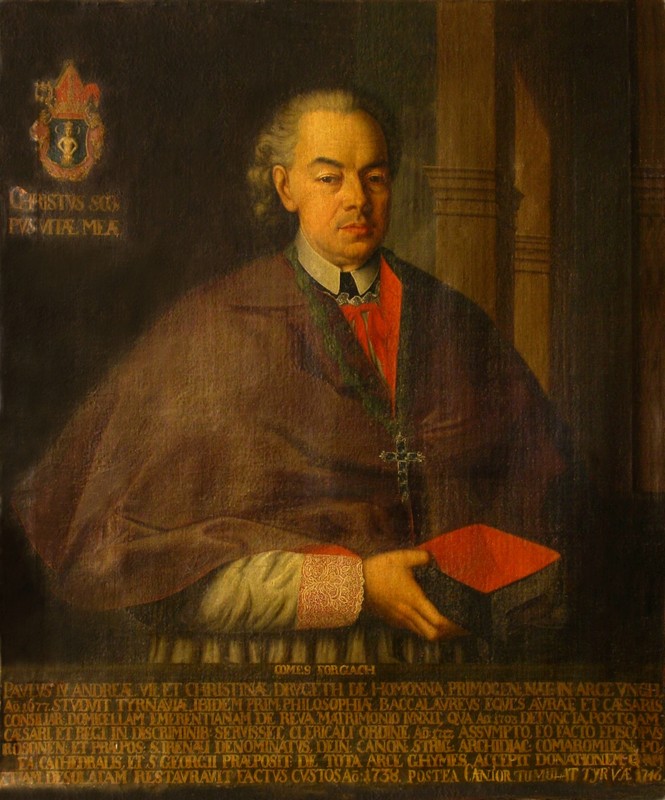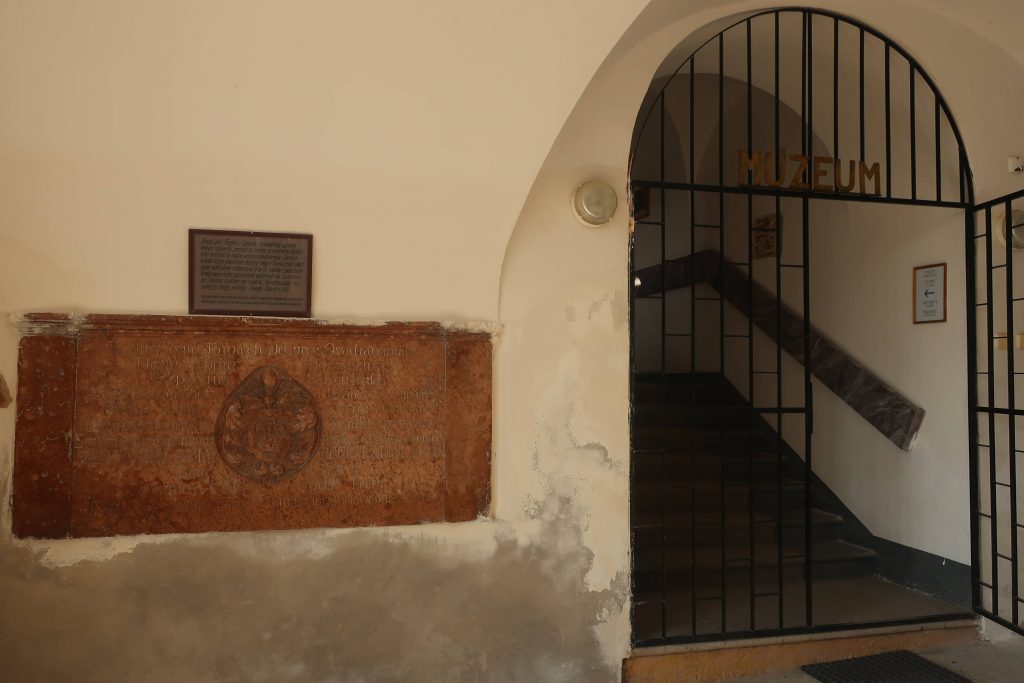Establishment of the of the Manor House of Draškovič

The Manor House of Draškovič was the last of the manor houses in Čachtice and took the name according to its builder, land judge, Moson and Orava main district administrator, Count Nikola Draškovič. According to the inventories from 1692 and 1711, the land judge built the residence from the ground up as a new building in 1677. By marrying the Countess Barbora Drugeth, the granddaughter of Elizabeth Báthory, Nikola inherited shares of the manor. Since he came from Croatia and did not own any other larger castle dominium in Hungary, he settled in Čachtice and members of the Drugeth family allocated him part of the manor and land in the landlord town for the construction of a new settlement. Male members of the Drugeth family had their own manor house in Čachtice and did not have to build another mansion. Nikola Draškovič built the main core of the manor house, a two- storey south wing, including a basement under the northern overhead tract, with a distinctive medium avant-corps.
Transfer of the Manor House to the ownership of the Forgách family
After the death of Nikola Draškovič, the object was inherited by his daughter, Countess Barbora Draškovič. After her death in 1691, the daughters of Barbora's cousin Zigmund Drugeth, Countesses Julianna and Clara Drugeth, inherited the manor house with the respective share. Since they were both girls at the time, the estate of Draškovič was managed by their mother and Zigmund's widow, Countess Teresa Keglevich. The widow was not interested in taking care of the Čachtice manor, too far from the centre of the Drugeth family domain, and began to gradually sell it or pledge it to third parties.
The shares disposed of by Teresa Keglevich were bought up by, among other nobles, Count Paul Forgách, Sr., who inherited part of the Drugeth estate from his mother and Zigmund Drugeth’s sister, Countess Krisztina Drugeth. In 1710, Forgách eventually also acquired the Draškovič share of the manor with the manor house from Keglevich, in exchange for the Forgách shares in Drugeth assets in Zemplín and Uh County. After taking over the Manor House of Draškovič, he moved to the building and set up a private chapel in it.
Paul Forgách, Sr. extended the manor house by adding a northwest two-storey wing. According to the files of the restoration of the manor house in the 1950s, there was a chapel in this wing but today it cannot be further located. It is believed that in 1715, Paul Forgách, Sr. installed a statue of the Virgin Mary in the niche of the southern facade, covering the older painted sundial. It is not certain whether he was the builder of the vast southwest wing (now doomed), captured on the 19th century maps.

After the death of his wife, Baroness Emerence Révay, Paul Forgách, Sr. became a member
of clergy. On 28 April 1721, as the titular episcopus rosoniensis and the Irenaeus provost, he
divided all the estates among his sons: Count Paul Forgách, Jr., Count Ladislav Forgách and
Count Jozef Forgách. In the case of Čachtice, he appointed all his sons as heirs who were to
take care of the estate together and only share its revenues. Of the three sons, only Ladislav
and Jozef Forgách became owners of the manor house because Paul Forgách, Jr. decided for
a religious career. On 15 November 1734, the siblings Ladislav and Jozef met in front of the
Monastery in Hronský Beňadik to sign a mutual exchange agreement. Since Ladislav planned
to settle in Čachtice, Jozef gave up his entire share in Čachtice manor in favour of Ladislav
and Ladislav gave him the village of Babindol in Nitra County in return.
Although Ladislav Forgách, a Counselor of the Royal Governor´s Council, had fifteen children
with four wives, only five of them lived to adulthood. Thanks to his more extensive heritage,
the manor house in Čachtice only got into the hands of the youngest son from his fourth
marriage, Count Nikola Forgách. He favorably married Baroness Jozefa Rudnyánszky. After
the wedding, the couple settled in Čachtice, but their union remained childless. After the
death of the Baroness, Nikola did not marry again, which is why he declared his niece,
Countess Mária Forgách, as a universal heiress. At the time of acquiring the manor house in
1850, Mária Forgách lived with her husband, Count Zigmund Forgách, in the territory of the
Abov County in the manor house in Slanica or the municipal palace in Košice. The distance
between the territory and the Manor House in Čachtice led to the sale of the manor house,
which, according to the county monograph, took place in 1852.
Sale of the Manor House to the last owners – the Czenkay family
From the preserved historical sources, this year could not be verified, but it was possible to complete the data on sellers and buyers. When selling the property, Mária was represented by her brother, Count Karol Forgách, and Michal Czenkay acquired the property. After his death, his heirs, who were listed in the land register of Čachtice in 1863, 1868 and 1880, became the owners. According to the file of the village of Čachtice, Michal's widow, Terézia Boróczy, acted as the administrator of the property and represented Michal’s minor children for some time. After reaching adulthood, Michal's sons – Gejza Czenkay, Ladislav Czenkay and Adolf Czenkay – took ownership.
The Manor House of Draškovič as a dosshouse for the poor
In the 19th and early 20th century, the manor house served as a dosshouse for poor population, which had fatal effects on its condition. Under the former regime, the building underwent major reconstruction. Two wings built by the Forgách family were removed, and the altar stone, which was left in the former chapel, is mounted in the wall under the gate on the left. In the 1960s, a museum was established there. The manor house is now one of the branches of the Museum of Trenčín.

Source: JANURA, Tomáš - ZVAROVÁ, Zuzana. Kaštieľ Draškovičovcov v Čachticiach [Draskovich manor house in Čachtice]. In Pamiatky a múzeá : revue pre kultúrne dedičstvo, 2020, Vol. 69, No. 4, pp. 9- 15.